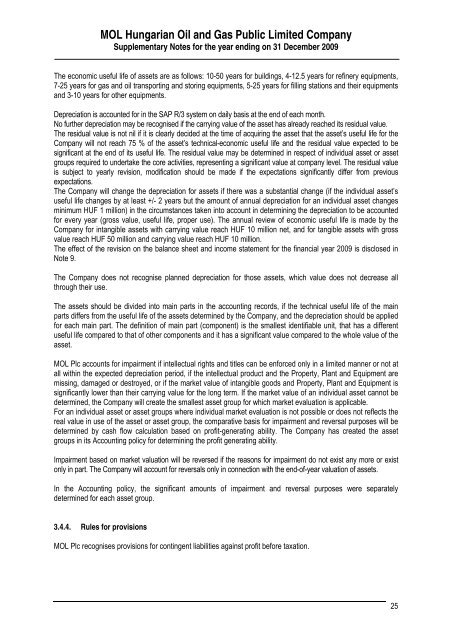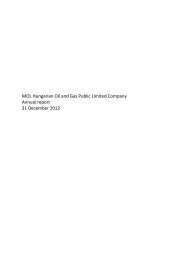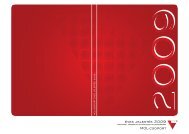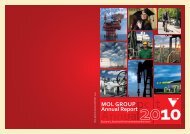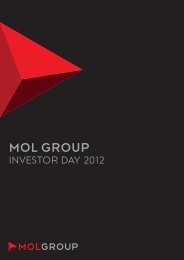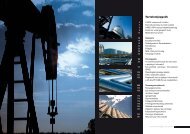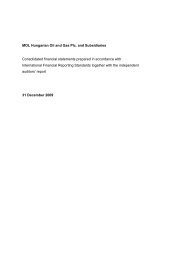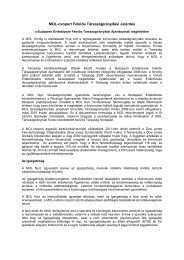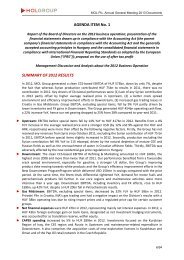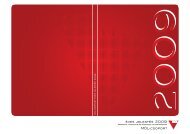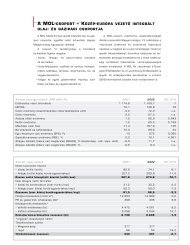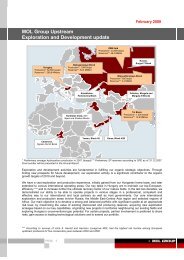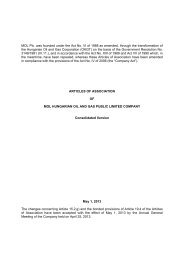MOL Hungarian Oil and Gas Public Limited Company
MOL Hungarian Oil and Gas Public Limited Company
MOL Hungarian Oil and Gas Public Limited Company
You also want an ePaper? Increase the reach of your titles
YUMPU automatically turns print PDFs into web optimized ePapers that Google loves.
<strong>MOL</strong> <strong>Hungarian</strong> <strong>Oil</strong> <strong>and</strong> <strong>Gas</strong> <strong>Public</strong> <strong>Limited</strong> <strong>Company</strong>Supplementary Notes for the year ending on 31 December 2009The economic useful life of assets are as follows: 10-50 years for buildings, 4-12.5 years for refinery equipments,7-25 years for gas <strong>and</strong> oil transporting <strong>and</strong> storing equipments, 5-25 years for filling stations <strong>and</strong> their equipments<strong>and</strong> 3-10 years for other equipments.Depreciation is accounted for in the SAP R/3 system on daily basis at the end of each month.No further depreciation may be recognised if the carrying value of the asset has already reached its residual value.The residual value is not nil if it is clearly decided at the time of acquiring the asset that the asset’s useful life for the<strong>Company</strong> will not reach 75 % of the asset’s technical-economic useful life <strong>and</strong> the residual value expected to besignificant at the end of its useful life. The residual value may be determined in respect of individual asset or assetgroups required to undertake the core activities, representing a significant value at company level. The residual valueis subject to yearly revision, modification should be made if the expectations significantly differ from previousexpectations.The <strong>Company</strong> will change the depreciation for assets if there was a substantial change (if the individual asset’suseful life changes by at least +/- 2 years but the amount of annual depreciation for an individual asset changesminimum HUF 1 million) in the circumstances taken into account in determining the depreciation to be accountedfor every year (gross value, useful life, proper use). The annual review of economic useful life is made by the<strong>Company</strong> for intangible assets with carrying value reach HUF 10 million net, <strong>and</strong> for tangible assets with grossvalue reach HUF 50 million <strong>and</strong> carrying value reach HUF 10 million.The effect of the revision on the balance sheet <strong>and</strong> income statement for the financial year 2009 is disclosed inNote 9.The <strong>Company</strong> does not recognise planned depreciation for those assets, which value does not decrease allthrough their use.The assets should be divided into main parts in the accounting records, if the technical useful life of the mainparts differs from the useful life of the assets determined by the <strong>Company</strong>, <strong>and</strong> the depreciation should be appliedfor each main part. The definition of main part (component) is the smallest identifiable unit, that has a differentuseful life compared to that of other components <strong>and</strong> it has a significant value compared to the whole value of theasset.<strong>MOL</strong> Plc accounts for impairment if intellectual rights <strong>and</strong> titles can be enforced only in a limited manner or not atall within the expected depreciation period, if the intellectual product <strong>and</strong> the Property, Plant <strong>and</strong> Equipment aremissing, damaged or destroyed, or if the market value of intangible goods <strong>and</strong> Property, Plant <strong>and</strong> Equipment issignificantly lower than their carrying value for the long term. If the market value of an individual asset cannot bedetermined, the <strong>Company</strong> will create the smallest asset group for which market evaluation is applicable.For an individual asset or asset groups where individual market evaluation is not possible or does not reflects thereal value in use of the asset or asset group, the comparative basis for impairment <strong>and</strong> reversal purposes will bedetermined by cash flow calculation based on profit-generating ability. The <strong>Company</strong> has created the assetgroups in its Accounting policy for determining the profit generating ability.Impairment based on market valuation will be reversed if the reasons for impairment do not exist any more or existonly in part. The <strong>Company</strong> will account for reversals only in connection with the end-of-year valuation of assets.In the Accounting policy, the significant amounts of impairment <strong>and</strong> reversal purposes were separatelydetermined for each asset group.3.4.4. Rules for provisions<strong>MOL</strong> Plc recognises provisions for contingent liabilities against profit before taxation.25


